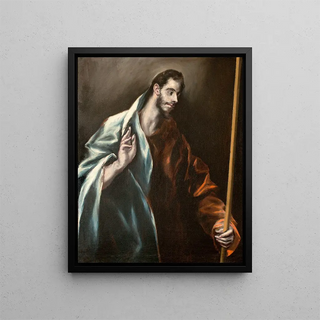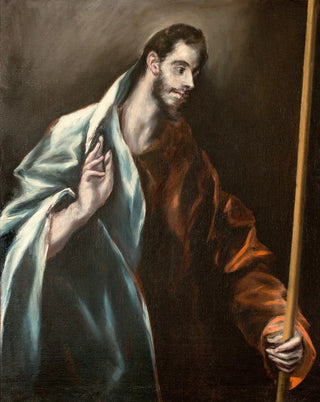Painting Apostle Saint Thomas - El Greco | Art print


View from behind

Frame (optional)
"Apôtre Saint Thomas" by El Greco is an iconic piece that embodies the spiritual depth and emotional richness of Spanish Renaissance painting. In this depiction, the saint, often associated with doubt and faith, is portrayed with an intensity that transcends a simple portrait. The posture of the figure, his gaze, and the details of his expression reveal an inner quest, a struggle between certainty and uncertainty. This artwork does not merely depict a man; it invites the viewer to delve into the complexities of the human condition, exploring questions of belief and knowledge.
Style and uniqueness of the artwork
El Greco, whose real name is Domenikos Theotokopoulos, is renowned for his distinctive style that blends Byzantine influences with elements of Italian Renaissance. In "Apôtre Saint Thomas," the vibrant color palette, ranging from deep blues to fiery reds, creates an almost mystical atmosphere. The elongated forms and exaggerated proportions of the figures are characteristic of his approach, imparting a spiritual dimension to his subjects. The play of light and shadow, along with the meticulous details of the saint's garment, demonstrate unparalleled technical mastery. Every brushstroke seems charged with meaning; each drapery tells a story. This piece, through its originality, stands out from more traditional saint representations, offering a personal and introspective vision that continues to fascinate art enthusiasts.
The artist and his influence
El Greco, born in Crete, carved a unique path in the art world, establishing himself in Toledo where he left an indelible mark. His innovative style influenced many artists, from contemporaries to subsequent generations, including iconic figures like Picasso and Soutine. By integrating mystical elements and intense expressiveness into his works, El Greco captured the essence of the human experience, transcending the limits of his time. His exploration of religious and spiritual themes, as exemplified by "Apôtre Saint Thomas," paved the way for a new understanding of sacred painting, where emotion and spirituality converge in harmonious unity.

Matte finish

View from behind

Frame (optional)
"Apôtre Saint Thomas" by El Greco is an iconic piece that embodies the spiritual depth and emotional richness of Spanish Renaissance painting. In this depiction, the saint, often associated with doubt and faith, is portrayed with an intensity that transcends a simple portrait. The posture of the figure, his gaze, and the details of his expression reveal an inner quest, a struggle between certainty and uncertainty. This artwork does not merely depict a man; it invites the viewer to delve into the complexities of the human condition, exploring questions of belief and knowledge.
Style and uniqueness of the artwork
El Greco, whose real name is Domenikos Theotokopoulos, is renowned for his distinctive style that blends Byzantine influences with elements of Italian Renaissance. In "Apôtre Saint Thomas," the vibrant color palette, ranging from deep blues to fiery reds, creates an almost mystical atmosphere. The elongated forms and exaggerated proportions of the figures are characteristic of his approach, imparting a spiritual dimension to his subjects. The play of light and shadow, along with the meticulous details of the saint's garment, demonstrate unparalleled technical mastery. Every brushstroke seems charged with meaning; each drapery tells a story. This piece, through its originality, stands out from more traditional saint representations, offering a personal and introspective vision that continues to fascinate art enthusiasts.
The artist and his influence
El Greco, born in Crete, carved a unique path in the art world, establishing himself in Toledo where he left an indelible mark. His innovative style influenced many artists, from contemporaries to subsequent generations, including iconic figures like Picasso and Soutine. By integrating mystical elements and intense expressiveness into his works, El Greco captured the essence of the human experience, transcending the limits of his time. His exploration of religious and spiritual themes, as exemplified by "Apôtre Saint Thomas," paved the way for a new understanding of sacred painting, where emotion and spirituality converge in harmonious unity.
12,34 €






